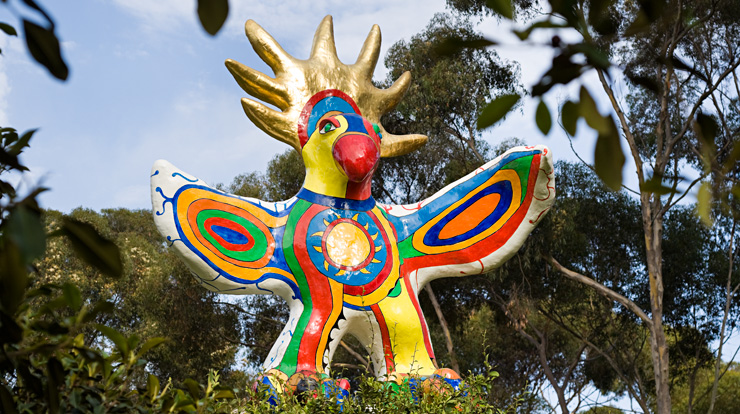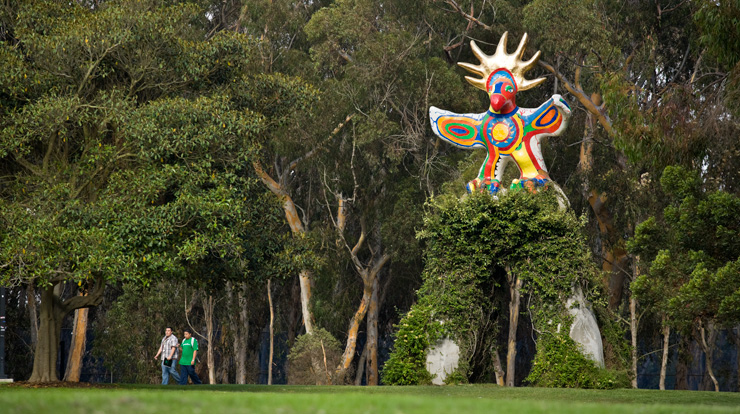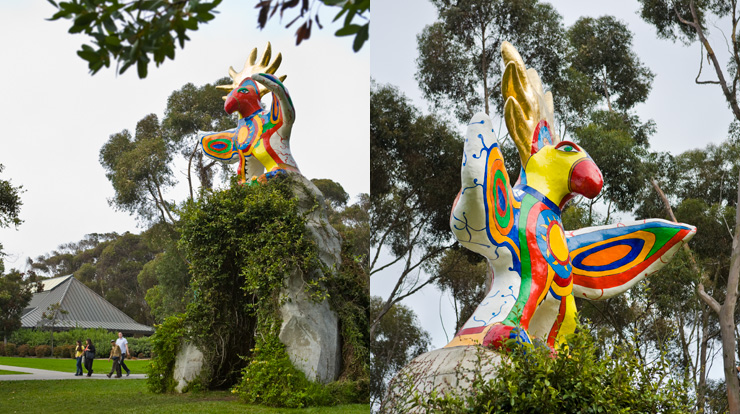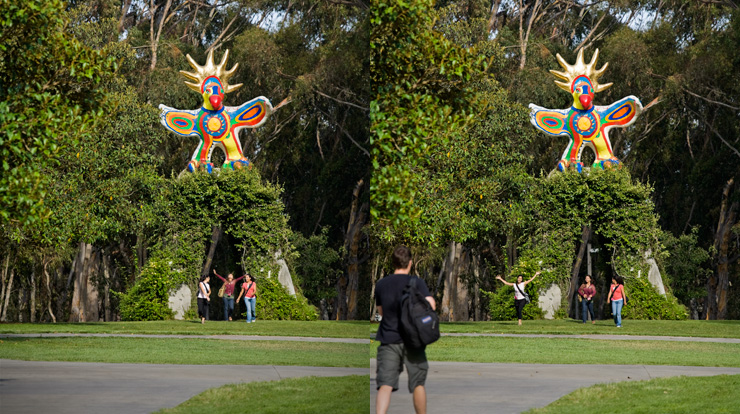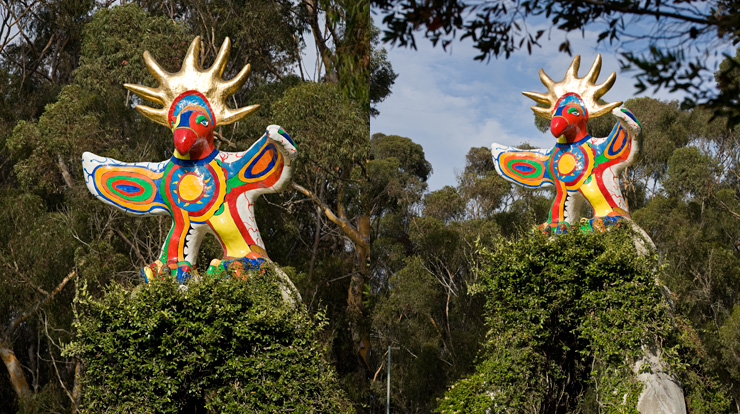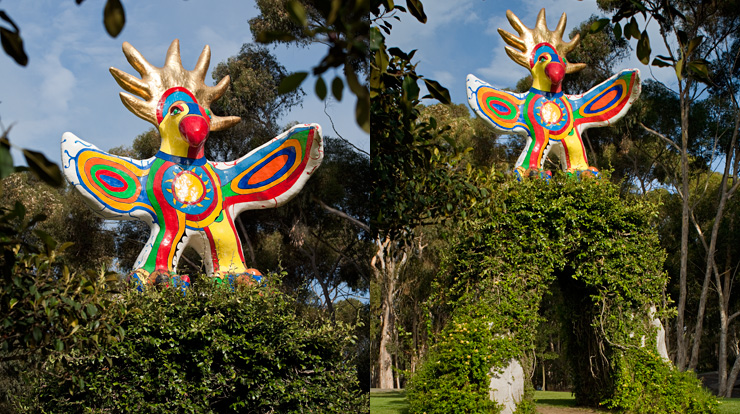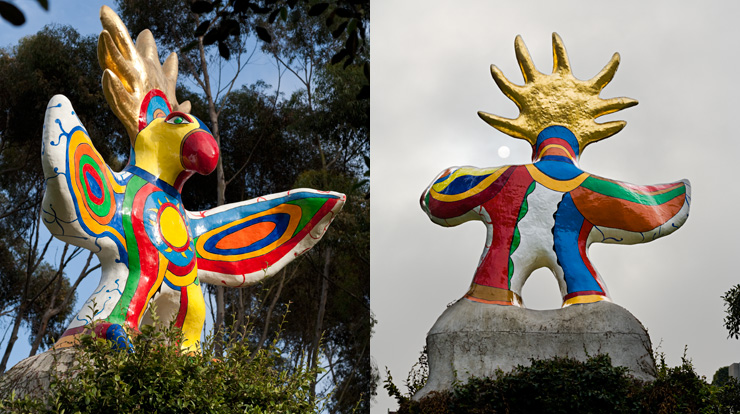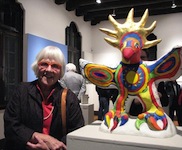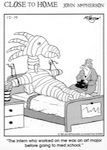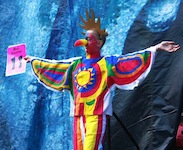Niki de Saint Phalle
Sun God, 1983
Location: Sun God Lawn
Audio Tour
Niki de Saint Phalle 1930-2002
About the Artist
Niki de Saint Phalle (1930-2002) is best known for her oversized figures that embrace contradictory qualities such as good and evil, modern and primitive, sacred and profane, play and terror. Her exaggerated "earth mother" sculptures, the Nanas, playfully explore ancient feminine deities while celebrating modern feminism's efforts to reconsider and revalue the woman's body. De Saint Phalle has made monsters and beasts into architectural forms for playgrounds and schools. These works demonstrate her deep interest in architects like Antoni Gaudi, whose organic and fluid buildings incorporate wild fantasies and highly crafted objects. Her collaboration with the Swiss artist Jean Tinguely on a landmark fountain for the plaza of the Centre Pompidou in Paris is world-renowned. She created a park in northern Italy full of giant sculptures based on Tarot cards; many can be entered and one is a functional residence.
Although de Saint Phalle lived near Paris for more than twenty years, her artistic formation has been as much North American as European. She lived in New York from 1933 to 1951 and again in the 1960s when she was prominent in the development of "happenings" and other artistic efforts involving the integration of art and life. She lived and worked in La Jolla from 1992 until her death in 2002.
About the Sculpture
Essay
Niki de Saint Phalle, Sun God, 1983
When I arrived in San Diego, the agreement between the Stuart Foundation and the Regents of the University of California had not been completely defined, but the advisory board had invited Niki de Saint Phalle and Jean Tinguely—who had collaborated frequently—to make proposals. When they visited the campus together, in 1981, Tinguely wanted to create a fountain. Concerned about droughts and the long-term cost of maintenance, the university was not predisposed to encourage this idea, and after considerable deliberation the Stuart Collection board chose Niki to make the first work on campus.
Niki was best known at the time for her “Nana” works, large, colorful female figures that played on ancient traditions of feminine deities while celebrating feminism’s revaluation of the bodies of women. Whatever she might do was likely to elicit both delight and outrage, and she would surely bring a burst of color to the gray concrete of the campus, something in opposition to the solemn monumentality of traditional public art. It would also be Niki’s first major outdoor work in America.
Niki was born in France but grew up in both Europe and the United States. She discovered art while young, and found it a salvation for her psyche. She has described working as a “fruitful trauma.” By the early 1960s she was achieving respect and notoriety for her “shooting paintings,” the products of public events that she orchestrated: having made a kind of collage with bags of paint embedded in it, she would shoot at it with a gun, making the paint splatter and drip. Niki became known as a member of the Nouveau Réalistes, a group of artists including Jean Tinguely, Pierre Restany, Arman, César, and Christo, among others. Niki also soon gained the attention and friendship of American artists Allan Kaprow, Robert Rauschenberg, Ed Kienholz, Merce Cunningham, and John Cage, whose interest in spontaneity and chance she shared.
Niki’s influences include Matisse and Picasso, Klee and Henri Rousseau, ancient and so-called primitive art, fairy tales and gargoyles, magic realism, carnivals, folk art, and the architecture of Antoni Gaudí. The force of her personality is clear in her sculpture, which has an irrepressible humor and innocence in tension with an underlying seriousness. Conquering fear with humor is a recurring theme.
Niki proposed three possibilities for the Stuart Collection: a Life Saviour, a Nana House, and Sun God. The latter was her preference, and eventually the board’s as well. Niki saw this giant colorful bird with outstretched wings as “an homage to the Southwest.” She sent a maquette for the board’s consideration and the project was set in motion.
Niki returned to the campus in the fall of 1981, choosing a lawn area near the Mandeville Center as the site. Her original arched base was to be constructed in concrete on site at UC San Diego. The fiberglass bird itself would be made in France, at the studio of Robert Haligon, longtime fabricator of Niki’s large-scale works. Meanwhile, in collaboration with the Mandeville Gallery (now the University Art Gallery), we planned an exhibition, Niki de Saint Phalle: Monumental Projects, to run in October–November 1981.
There were many reasons to go to Europe in the summer of 1982, and seeing the progress on Sun God was high on the list. A small group including Jim and Marne deSilva traveled to the French countryside to Haligon’s studios, Niki’s fiberglass “foundry,” not far from her house in Soisy-sur-Ecole. The Haligon family has been fabricating sculpture for artists going back to Rodin. Here we saw the giant pattern for Sun God. The production process, involving a mechanical pantograph, was fascinating, and Mathieu Gregoire, whose first language was French, became involved in order to coordinate the process and build the pedestal archway in San Diego. We went to Niki’s house and then, with her, to Jean Tinguely’s, where Pontus Hulten and Pierre Restany joined us for dinner. In the twilight we journeyed out to a nearby wood to see a giant outdoor sculpture that Tinguely, Niki, and other artists had been working on sporadically since 1969. This was Le Cyclop, an eighty-foot-high mechanized “head”—a composite assemblage of industrial by-products, furniture, and even a real boxcar cantilevered out from the back of the “skull.” With some ado, Tinguely and his assistants started the generator. The head groaned into action: chairs went up and down, couches back and forth, “eyeballs” rolled out of “sockets” and down a giant trough, and were taken back up to repeat their descent. Inside there were living and cooking facilities, and a small theatre where all the audience seats were in motion. At the top was an algae-covered pool that Tinguely said was an homage to Yves Klein, and the boxcar turned out to be one of the cars used in the Holocaust deportations, filled with nightmarish sculptural images by Niki. Later Pontus Hulten suggested that the Stuart Collection buy this extraordinary construction, but it was obviously at home in the forest.
By fall we were getting ready to begin building the pedestal on campus. Niki, still back in France, hadn’t determined the exact and final siting, and her schedule and her health weren’t going to permit a visit for some time. During this time she also revised the arch, in collaboration with Jean Tinguely, into a taller and more dramatic structure. We were eager to proceed with the work, so Niki suggested we go ahead and fix the location. When Mathieu went out to do this, he saw a young couple was lingering in the general area, and the woman had a large parrot on her shoulder. Sun God, a birdlike creature, was to be in bright parrot colors. They sat down, and the woman took the parrot off her shoulder and set it on the ground. Mathieu marked the exact spot, and the site was fixed. This really happened.
The form was accurately scaled up from the 1:5 scale model using steel, wire mesh, and air-entrained concrete, a process called gunite. The bird itself would not arrive for several months, and the finished arch alone was a strange sight, which produced mysterious rumors throughout the campus.
The bird was shipped from France in a slatted crate, arriving in the port of Long Beach in late January 1983. After customs clearance it was put on a flatbed truck and driven down the freeway, sideways, visible through the slats—another strange sight. We had arranged a celebration for the joining of the bird with the arch. People flocked to the site. A crane lifted Sun God, wrapped in packing garb, and “flew” it to the base. It was cemented in and the Stuart Collection really had begun: our bird was here to stay.
This zany object was met with a mixture of delight, dismay, and distress. There had been pessimistic forecasts from some about the physical fate of sculpture on campus, so I was very nervous about Sun God’s well-being on its first night. I slept fitfully, and hurried to school early in the morning to make sure all was well. The bird was still there, and I saw no graffiti, but on the ground at the base there was something strange—a very large handmade paper egg. The unknown artists had written greetings: “Happy Birthday,” and, since this was an egg, “Happy Easter.” A mascot was born.
Less than a year later, the Associated Students of UCSD, the undergraduate student government, began the process of organizing a Sun God Festival, their first such activity, which has become an annual event that celebrates the end of classes and offers an excuse for revelry before the start of exams. Attendance estimates now top 40,000 joyful students.
Right away Sun God became a landmark, a place where people arrange to meet or leave notes for one another. It has never been damaged, but is often the target of fun: it has worn a cap and gown for graduation; cardboard sunglasses; earphones and a box hanging from one wing saying “Sony Walkbird”; and a bandolier, a machete, and a headband saying “Rambird.”
Sun God can be interpreted as a phoenix raised from an ancient civilization, an enlightened presence, or an advertisement for the toys on sale at the Tijuana/San Diego border. Its gender has been widely debated. Once, a large straw nest appeared at its base, filled with chicks made from found wrappers, wires, and other cast-off junk, making the bird a mother. On another occasion this great figure became distinctly male, donning a huge yellow penis with testicles in the form of two orange basketballs. A newspaper reporter called to ask if we were waiting for help from the School of Medicine to take this new appendage down. I asked if he was going to publish a picture of it: “Oh no, we’re a family paper.”
In 1989, on a more somber note, a graduate class made a giant black shroud to “take away” the bird on that year’s Day without Art, the annual commemoration of the devastating losses to the creative community from AIDS. The effect was stark and powerful. Clearly Sun God made its way almost immediately into the life and traditions of the campus, and remains a participating citizen. In the memories of graduates and visitors, it is a standout. A number of alumni have reported that whether or not they paid much attention to the Stuart Collection when they were students, they carry the images with them, and when they’ve encountered Niki’s work in particular elsewhere (such as the Stravinsky Fountain, her collaboration with Tinguely in Paris), they feel a great sense of recognition, pride, and ownership.
Sun God incorporates many opposing forces, and so, true to form, its audacity belies its fragility. The color is vulnerable to the ultraviolet rays in sunlight, and the surface has undergone conservation to restore the original brilliance of the palette. The sculpture has twice been sanded back to pure white before the reapplication of resin. The crown is covered in gold leaf, which lasts much longer than pigment. It is in many ways a living creature, which despite its traditional presentation as sculpture-on–a-pedestal has, because of its integration into the life of the university, become one of the most site-specific projects in the Stuart Collection.
Interview with the Artist
Niki de Saint Phalle Interview with Joan Simon
Joan Simon: You were the first artist commissioned to make a work for the Stuart Collection.
Niki de Saint Phalle: When I came to UCSD, Jim DeSilva rented a helicopter to go around the campus for me to choose the place for my piece—and I was scared to death. I thought a lot about the roots of California, which were Native American and Mexican. I wanted something that would mean something on a spiritual level. And I chose an eagle.
The sculpture was contested a bit at first, and then it became the mascot. The students like it. It’s a place where they meet. The thing that matters for me is that the students really use it, it’s a place of rendezvous: “Meet you at the Sun God.”
JS: When you were first contacted [to do a work for the collection], what do you remember of the process?
NdSP: I know that Pontus Hulten, who has been a lifetime supporter of my work, was on the committee. I know that Pierre Restany, who is a French critic, was on it. I think it was an international board. They also wanted Jean Tinguely to do something, but he proposed a fountain and they said, there’s not enough water. It’s too bad it didn’t happen, Jean had chosen his spot, but somehow it didn’t work out.
JS: The Sun God seems to relate to two other bird sculptures of yours—the one in the Stravinsky Fountain, your collaborative work with Tinguely near the Centre Pompidou, Paris [1982–82], and the one in your Tarot Garden at Garavicchio in Tuscany, the complex of monumental sculptures and architectural works that you began in 1979 and that opened to the public in 1993. There the motifs are based on the twenty-two cards of a tarot deck.
NdSP: The one in Italy is similar to this one, but it is done in tile instead of being painted. The one at the Stravinsky Fountain is smaller; it’s different, but it’s in the same family.
JS: Were they conceived at the same time?
NdSP: The Sun God was first, then came the one in Italy, and later the one in Paris— from a Stravinsky opera, The Firebird. Birds have been a major theme in my work; I think they’re free and spiritual. I hope if I get reincarnated I’ll get turned into a bird. I love their magic, their freedom.
JS: When you talk of the bird in tile, I’m reminded of your interest in the Catalan architect Antoni Gaudí and the French postman Ferdinand Cheval, a kind of architectural folk artist. You have called them both heroes of yours.
NdSP: I first encountered Gaudí’s work when I was twenty-five, when I was living in Majorca with my husband, Harry Mathews. We were living like hippies before their time. Walter Auerbach, a very intelligent man and a friend from New York, said, “Niki, you have to go to Barcelona and see Gaudí. It’s going to change your life. I feel it already in your work.” So I took a trip, and I really had the feeling that [Gaudí’s Parc Güell] was a message sent to me—that I, too, must do a garden of joy to give people happiness. It took years and years before I started the Tarot Garden.
JS: And Raymond Isidore, and his Maison Picassiette in Chartres? And Cheval?
NdSP: He was totally great, the Facteur Cheval. I don’t know how many times I’ve gone down there. Jean was really involved with these outsiders. He saw the terrific freedom of being an outsider that people don’t have when they’re enveloped in the art system.
JS: You have spoken of how important Gaudí and Cheval were for you. Cheval worked on his Palais Idéal, in Hauterives, France, for over thirty years; Gaudí worked on Parc Güell for ten. You say that this work had no intermediary—no galleries or museums—that it had a direct kind of beauty. You also say that although Tinguely changed his opinion, he was initially against this type of work because he thought art needed to be within society, not outside it. (see note)
(note: Niki de Saint Phalle, “Printemps 90/Cher Jean/qui est le monster toi ou moi?” in “Lettres,” Niki de Saint Phalle, exh. cat. (Paris: Musée d’Art Moderne de la Ville de Paris, 1992),153.)
NdSP: That’s what he thought. Then when he saw the Facteur Cheval’s work and the Watts Towers, he totally changed his mind, and he built his own “outsider” sculpture —the Cyclops in the forest [1970, Milly-la-Forêt, France]. (see note)
(note: Sometimes called La Tête [the head] as well as the Cyclops, this monumental sculpture, over seventy feet high, was built with the participation of Eva Aeppli, Bernhard Luginbuhl, Giovanni Podesta, Jean-Pierre Raynaud, Jesus Rafael Soto, Daniel Spoerri, and de Saint Phalle. The façade, of mosaic mirrors, is by de Saint Phalle.)
JS: What do you think made for the change of mind?
NdSP: He was overwhelmed by the savage beauty of these artworks. Jean was at heart a rebel, and most outsiders are rebels. Gaudí was very lucky; he had a benefactor who financed Parc Güell. Sometimes I used to curse him, my master, when I was doing the Tarot Garden. I was really jealous—he had all this help and I had to find the money. The Facteur Cheval did it all on his own too. I also felt it was my karma to have to finance and build this garden to show that a woman was capable of taking on such a task. (see note)
(note: See John Maizels, “Fantasy Worlds: Introduction,” in Deidi von Schaewen and Maizels, Mondes Imaginaires (Cologne, London, Madrid, New York, Paris, and Tokyo: Taschen, 1999), 14.)
JS: How did you finance it?
NdSP: By doing a perfume, by making vases. I thought if I made art objects to embellish the home I could make money, and I did, probably because I made them with the same love and care that I do my sculptures. My multiples have done extremely well. People like to have a chair or a vase, it makes their house gay—and that helped to support my other work. I managed the Tarot Garden, but sometimes it was very tough.
JS: Was there a moment when you felt you had really come into your own as an artist?
NdSP: I loved doing the shooting paintings. I was, of course, a scandal then. I had this great dealer, Alexandre Iolas, who bought all my early work, and let me survive by giving me enough money to live and work. Rauschenberg bought a shooting painting; Jasper [Johns] was enthusiastic; [Ed] Kienholz was a big supporter—all of which was very important to me. This was about 1961.
Then afterwards I went on to different things, but as I moved on, my early work got lost. Nobody would show them or buy them. They were ignored. That’s why I’m very happy with the major donation I made to the Sprengel Museum [in Hannover], because they concentrated on the early work. I feel, at last I’m being seen as a complete artist.
JS: In 1987, in collaboration with Silvio Barandun, you wrote and illustrated an important and accessible AIDS awareness book, AIDS—You Can’t Catch It Holding Hands. (see note)
(note: De Saint Phalle, with Silvio Barandun, AIDS—You Can’t Catch It Holding Hands (San Francisco and Santa Monica: Lapis Press, 1987). Also published in French, Italian, and German editions.)
NdSP: The book was published by Sam Francis’s Lapis Press. He didn’t want people to know it was his publishing company. He never wanted to show all the good things he did. But I came out and said, “Sam, I’m sorry, I’m going to say you did it. I want people to know.”
JS: More recently you published the first volume of your autobiography, Traces. (see note) Why now?
(note: De Saint Phalle, Traces, vol. 1 (Lausanne: Acatos, 1999).)
NdSP: I see all the lies about Tinguely after his death, and two books have come out about me that have many things wrong. I don’t believe in truth, I believe in perception.
JS: In the period of that early work, in Paris in the late ’50s, you were part of an important community of artists—Yves Klein—
NdSP: —Joan Mitchell, Riopelle—
JS: —Giacometti, Tinguely, Saul Steinberg, all involved with each other’s work. In your autobiography you say that when Mitchell treated you as the wife of a writer [Mathews]—
NdSP: —I think she was provoking me—
JS:— it charged you to work very hard to—
NdSP: Not to work very hard; I was already working all day long, as hard as I could. But I didn’t want to be taken for an amateur, I couldn’t stand that, and I decided to impose myself on the art world. She did me a favor. I wanted to be recognized, and I wasn’t recognized by the art world, though I was by my fellow artists, and by Iolas.
JS: You were born in New York to a French father and an American mother. You lived in France for three years with your grandparents while your parents were back in New York, and then returned to America. As an adult you lived in France, Majorca, Italy, and now in the US again. Is there a particular place you would now call home?
NdSP: I’m glad I feel part of many cultures. It has given me liberty, freedom.
JS: I think it may surprise people to learn that you live in La Jolla.
NdSP: I love living in La Jolla. It’s been seven years. I was in such bad health, I told my doctor I wanted to join the Hemlock Society—I didn’t want to go on—and I asked my doctor if he could give me another option. After a few minutes he said, “Move to San Diego.”
JS: What are you working on now?
NdSP: I’m doing a garden in Escondido on Calafia, the legendary Queen of California. Soon after moving here, because of the incredible diversity of California landscape, my work and materials changed. In the Tarot Garden I used ceramics and both handmade and bought mirrors and glass. Here I’m using stones. I used them first for a project I’m doing for the Jerusalem Foundation, the Noah’s Ark project. The pieces were here in La Jolla for a year. I can find the stones here—at a big fair in Tucson, and many other places. I’ve also found new kinds of glass and mirror here, and the best collection of rocks in the country.
JS: In the last month or so you’ve been on the road—to Germany, and before that I heard you might have gone to Japan?
NdSP: I won the Imperial Prize in Japan. I couldn’t go, because my health wasn’t good, but I was pleased. I didn’t think I’d win something like that. Id never wanted to go to a major art gallery, so I don’t have that support, and I know this means not many reviews, not much writing, and I really didn’t think an international jury would pick me. I was very pleased.
JS: Do you feel part of a community of artists in San Diego?
NdSP: I’m known as a recluse here. They probably think I’m a little crazy, but I don’t care. They’re probably right. I like discovering new things. I’m always for new experiments. I’m interested in learning. There’s always something new to discover.
JS: Is there anything specific you’d like me to record about the Sun God?
NdSP: That I like the way it looked so much it influenced other works. You’ve seen the Tarot Garden book; that Sun God looks different, but there are big similarities. It’s a piece I feel very good about. And here I am back in the same place, working with Calafia, the legendary Queen of California.
